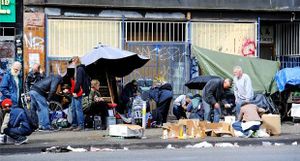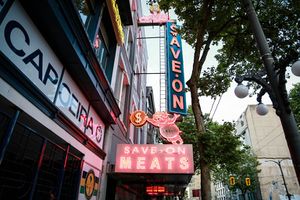Gentrification of Vancouver's Downtown Eastide
Gentrification
Gentrification is the process of transforming and renewing an undervalued neighbourhood, which results in improvements in the area’s private housing stock and public infrastructure[1], leading to a significant increase in house values and contract rents.[1] There has been much discussion on whether gentrification is an equitable solution towards urban planning. Gentrification is seen as favourable to investors as it addresses housing shortage issues and stimulates the economy through its urban characteristics. However, a major cost to gentrification is the subsequent displacement and marginalization of low income groups [2]including the homeless and elderly. As social housing is torn down to make room for housing in the private markets, low-income groups are forced to relocate after gentrification of its neighbourhood raises the value of the space[3]and housing affordability becomes an issue.
Resistance to Gentrification in Vancouver's Downtown Eastside
Hidden within Vancouver, North America’s most expensive city to live,[4] is also the home to one of Canada’s poorest neighbourhoods – the Downtown Eastside of Vancouver. The Downtown Eastside is notorious for its high population of impoverished individuals, as well as its extensive street crime including drug use and prostitution. The Downtown Eastside area has not seen gentrification in the area as rapidly as other neighbourhoods in Vancouver. Urban geographer, David Ley identifies that political mobilization, public policy[5], social and geographical features of the Downtown Eastside have slowed gentrification substantially.[5]
Geographical Limits
Urban geographer, David Ley has identified several geographical factors that encourage and discourage gentrification in the neighbourhood. Geographical characteristics that make a neighbourhood attractive for gentrification include its proximity to waterfront, close distance to downtown and also amenities such as a park, leafy streets, museum or a theatre.[5]For neighbourhoods without these characteristics, the value of the site depreciates.[5]Although the Downtown Eastside is situated close to downtown and near the waterfront, gentrification in this neighbourhood is limited due to the social barriers and political activism present in the district.
Social Limits
David Ley addresses several social factors that drive gentrifiers away from investing in the re-development of the Downtown Eastside. The deep poverty and high levels of street crime has made the streets of the Downtown Eastside too raw for most middle-class sensibilities.[5]With significant levels of drug use and abuse in the neighbourhood, there is a high prevalence of Hepatitis C, syphilis, and HIV-AIDS, in which 10 percent of its residents are estimated to be HIV-positive.[5] Furthermore, the homelessness situation has led to the addition of a number of emergency shelters throughout the streets. Residents in the area take part in street crime and prostitution as means to survival and support addictions.[5] Therefore, the explicit and appalling levels of street crime impede the smooth transition towards gentrification of this neighbourhood. Although there are numerous barriers to the process of gentrification in the Downtown Eastside, it is an ongoing and gradual process.
Political Mobilization
The government has an ongoing role in maintaining its ownership of social housing properties which have a high chance of being converted into expensive private residences. By constructing and subsidizing social housing[5] it removes housing from the private market. These strategies are efforts to guarantee that poor people will have a continuing presence in the district.[5]
Although the process of gentrifying the Downtown Eastside is slowed by the resistance from social activists and the government, there has been a notable increase in new restaurants and bars moving into the area. Majority of these restaurant businesses are unwelcoming to the poor residents in the community because of its prices and upscale environment. For example, Pidgin, a restaurant situated in the heart of the impoverished community, serves up $17 plates of scallops with fried polenta.[6]Activists believe this clashes with the low income neighbourhood[6] as it has a community which relies on affordable dining, living, and attainable social services.
Poverty Tourism
Poverty tourism is on the rise in Vancouver[3], especially through the restaurant industry in the Downtown Eastside. Poverty tourism[3]is a more complex form of displacement in which the weaknesses and distinctions of the impoverished population become an important selling point.[3]With the abundance of urban re-development in this rundown neighbourhood, it generates character and uniqueness, which is sought after by tourists and various creative pioneers. The marginalized community of the Downtown Eastside are at the forefront of this authentic experience tourists and outsiders of the community seek to witness. In some cases, people visit the area solely to see its infamous poverty.[3] This form of poverty tourism involves advertising the authentic culinary experiences by eating in spaces shared by locals,[3] referring to the infamous impoverished population of the Downtown Eastside. The impoverished community participate in this “authentic” experience through their labour in the production of food within these spaces of consumption[3]and also through their presence in the neighbourhood. In order to fuel this authentic experience, a power imbalance must be maintained. As the impoverished community are easily exploited due to their reliance on social assistance and low-wage service sector jobs, marginalization and displacement of these individuals to maintain "poverty tourism” can be easily achieved.
Next Steps
It is important to emphasize that the local community is not entirely against gentrification; however, they see a need to compromise.[6]Social activists believe they are responsible for fostering a community which produces a balanced and mixed neighbourhood[6], that is neither a ghetto nor an enclave for the rich.[6]One step towards this objective is by hiring from the neighbourhood[6]as an attempt to productively help the impoverished find their way out of poverty, and into recovery.[6]
Save-On-Meats
Save-On-Meats is a local business in the Downtown Eastside which is celebrated for its community-oriented approach to business. This renowned social enterprise[7] operates a diner, butcher shop, and subsidized sandwich window which hires a diverse population from the Downtown Eastside. The business owner, Mark Brand is dedicated to hiring from the community, including homeless, social assistance recipients, and individuals living with various barriers like mental disorders and drug addictions.[7] Save-On-Meat’s employment model ensures that the marginalized community has the opportunity to find employment that fosters skills development and provides job security.[8]In addition to their community-based employment model, Save-On-Meats is also renowned for its "Token Program".[7] Sandwich tokens can be purchased for as low as $2.25 and are handed out around the neighbourhood. The tokens are redeemable for dine-in or for take-out at the window. This initiative allows for meaningful face-to-face interactions between those in need and those who are lending a hand to their neighbours.
References
- ↑ Jump up to: 1.0 1.1 Hammel, D.J., (2009). Gentrification. International Encyclopedia of Human Geography. Retrieved from http://dx.doi.org.ezproxy.library.ubc.ca/10.1016/B978-0080449104.01051-8.
- ↑ Lees, L. (2015). International encyclopedia of the social & behavioral sciences: Gentrification Elsevier. Retrieved from http://www.sciencedirect.com.ezproxy.library.ubc.ca/science/article/pii/B978008097086874013X.
- ↑ Jump up to: 3.0 3.1 3.2 3.3 3.4 3.5 3.6 Burnett, K. (2014) Commodifying poverty: gentrification and consumption in Vancouver’s Downtown Eastside, Urban Geography, 35:2, 157-176. DOI: 10.1080/02723638.2013.867669.
- ↑ http://www.readersdigest.ca/travel/canada/10-most-expensive-cities-canada/
- ↑ Jump up to: 5.0 5.1 5.2 5.3 5.4 5.5 5.6 5.7 5.8 Ley, D., David Ley, & Cory Dobson. (2008). Are there limits to gentrification? The Contexts of Impeded Gentrification in Vancouver. Urban studies, 45, 2471-2498. doi: 10.1177/0042098008097103
- ↑ Jump up to: 6.0 6.1 6.2 6.3 6.4 6.5 6.6 Some activists are worried by the gentrification of vancouver's downtown eastside (2013). Toronto: Canadian Broadcasting Corporation. Retrieved from http://ezproxy.library.ubc.ca/login?url=http://search.proquest.com.ezproxy.library.ubc.ca/docview/1315723356?accountid=14656
- ↑ Jump up to: 7.0 7.1 7.2 http://www.markbrandinc.com/new/portfolio/save-on-meats/.
- ↑ (2012, May 08). Vancity's Stories of Impact - Save On Meats. Retrieved December 05, 2016, from https://www.youtube.com/watch?v=pZ51KNRDexk

